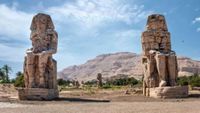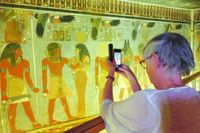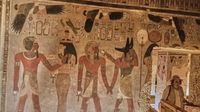After more than two decades shrouded in scaffolding and silence, the tomb of Pharaoh Amenhotep III, one of ancient Egypt’s most influential rulers, has reopened its doors to the world. On October 7, 2025, Egyptian authorities welcomed visitors back into the royal monument, catalogued as “WV 22” in the Valley of the Kings, marking a triumphant return for a site that had teetered on the brink of collapse and obscurity. For Egypt, the reopening is more than just another ribbon-cutting—it’s a powerful statement about the country’s dedication to preserving its rich heritage and reigniting global fascination with its storied past.
The tomb, nestled in a secluded part of the Valley of the Kings just outside Luxor, is no ordinary resting place. Dating back more than 3,000 years, it was first documented by French engineers during Napoleon’s campaign in 1799. Since then, it has witnessed waves of excavation, looting, and deterioration, with much of its original treasure now scattered across museums in Paris, New York, and the United Kingdom. As Waseda University in Japan has noted, the tomb’s contents were carted away after French and British excavations in the 18th and early 20th centuries, leaving behind a battered but still awe-inspiring monument.
Restoration efforts began in earnest in 1989, spearheaded by a dedicated team from Japan’s Waseda University and supported by UNESCO and the Japanese government. According to The Jerusalem Post, the project officially kicked off in 2004 and unfolded over three distinct phases: stabilization, cleaning and securing the tomb’s pillars, and finally, prevention with the installation of monitoring devices. The structure had suffered decades of neglect, with erosion, bat colonies, and salt deposits threatening its very foundation. Mohamed Ismail Khaled of Egypt’s Supreme Council of Antiquities remarked, “It was incredibly delicate work as the tomb was suffering from deterioration.”
More than 260 specialists participated in the painstaking restoration, which included rehabilitating the walls, sealing cracks in the columns, cleaning the ceiling’s golden stars, and reconstructing over 200 fragments of the red granite sarcophagus lid. The lid, now displayed on a metal base next to the empty frame of the stolen coffin, is a testament to both ancient artistry and modern perseverance. Restorer Mohamed Mahmoud, who has worked on the project since its inception, summed up the mood: “My happiness is indescribable on this historic day.”
Visitors today descend a winding, more than 100-foot downward passageway—now fitted with new wooden stairs and walkways—before arriving in a cavernous burial chamber. The room, supported by six columns and flanked by two side rooms, is adorned with wall paintings that Japan’s UNESCO mission describes as “among the most exquisite of those surviving in the royal tombs of the Eighteenth Dynasty.” The murals, with their vibrant blue and yellow tones, have survived more than three millennia and are now illuminated by a modern lighting system designed to both protect and highlight their beauty.
The tomb’s walls are more than just decorative—they’re a spiritual roadmap. Scenes from the Book of the Dead and passages from the Imi-Duat (intended to guide the king through the underworld) cover the surfaces, depicting Amenhotep III receiving life from ancient Egyptian gods and describing his journey through night and rebirth. According to UNESCO, these paintings are among the best-preserved from the Eighteenth Dynasty, offering an unparalleled glimpse into the beliefs and rituals of ancient Egypt’s golden age.
Although Amenhotep III’s tomb was looted shortly after its documentation in 1799, the mummy itself survived, thanks to ancient priests who moved it to the tomb of his grandfather, Amenhotep II. Today, the damaged mummy is displayed at the National Museum of Egyptian Civilization in Cairo, alongside 16 other royal mummies. The granite sarcophagus, too heavy for looters to carry away, remains in the tomb—now restored and serving as a silent guardian of the pharaoh’s legacy.
Amenhotep III, also known as Amenhotep the Great, ruled from 1387 BC to 1349 BC, ascending to the throne as a teenager and presiding over nearly four decades of peace, stability, and artistic grandeur. His reign is often considered a peak in ancient Egyptian civilization, marked by economic prosperity, extensive trade networks, and monumental building projects. Among his most famous legacies are the Colossi of Memnon, two massive granite statues that still stand near his mortuary temple at Kom el-Hitan, and additions to the temples at Karnak and Luxor.
The reopening of the tomb comes at a pivotal moment for Egypt’s tourism industry, which has struggled to recover from the downturn following the 2011 uprising. Officials hope that the restoration of WV 22 will help boost visitor numbers and reaffirm Egypt’s status as a top destination for cultural tourism. As Minister of Tourism and Antiquities Ahmed Issa put it during the inauguration ceremony, “The opening of the tomb of King Amenhotep III will be a global event that reflects Egypt’s effort to preserve and promote our heritage.” Sherif Fathy, who unveiled the tomb to reporters, called the restoration “an extraordinary achievement” and praised the collaboration between Egyptian and Japanese specialists.
The timing could hardly be better. Less than a month from now, Egypt will inaugurate the Grand Egyptian Museum, a $1 billion project that has been under construction since 2002. The museum will house many of King Tutankhamun’s treasures as well as more than 100,000 artifacts from across Egypt’s long and complex history. The reopening of Amenhotep III’s tomb is seen as a prelude to this grand unveiling, drawing the world’s gaze back to Luxor and the wonders of the ancient Nile.
For visitors, the experience is both humbling and exhilarating. After a descent into the earth, surrounded by the echoes of history and the glow of restored murals, they stand face-to-face with the artistry and ambition of a civilization that continues to captivate the imagination. The tomb’s reopening is not just about the past—it’s a reminder that, with care and collaboration, even the most fragile legacies can endure.






